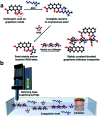A facile route to mechanically robust graphene oxide fibers
- PMID: 35514722
- PMCID: PMC9065756
- DOI: 10.1039/c9ra03945g
A facile route to mechanically robust graphene oxide fibers
Abstract
Excellent mechanical, electrical, and thermal properties of graphene have been achieved at the macroscale by assembling individual graphene or graphene oxide (GO) particles. Wet-spinning is an efficient and well-established process that can provide GO assemblies in fiber form. The coagulation bath in the wet-spinning process has rarely been considered for the design of mechanically robust GO fibers (GOFs). In this study, locating the amidation reaction in the coagulation bath yielded mechanically improved GOFs. The imides 1-ethyl-3-(3-dimethylaminopropyl)carbodiimide and N-hydroxysuccinimide were used to form covalent amide bonds between GO flakes and chitosan, thereby reinforcing the GOFs. Evidence and effects of the amidation reaction were systematically examined. The tensile strength and breaking strain of the GOFs improved by 41.6% and 75.2%, respectively, and the toughness almost doubled because of the optimized crosslinking reaction. Our work demonstrated that using a coagulation bath is a facile way to enhance the mechanical properties of GOFs.
This journal is © The Royal Society of Chemistry.
Conflict of interest statement
There are no conflicts to declare.
Figures







Similar articles
-
Wet-spun graphene filaments: effect of temperature of coagulation bath and type of reducing agents on mechanical & electrical properties.RSC Adv. 2018 May 14;8(31):17443-17452. doi: 10.1039/c8ra02325e. eCollection 2018 May 9. RSC Adv. 2018. PMID: 35539226 Free PMC article.
-
Fabrication of strain-sensing fibers with silver nanoparticles and reduced graphene oxide via wet spinning.Nanotechnology. 2025 Jan 6;36(10). doi: 10.1088/1361-6528/ada2f4. Nanotechnology. 2025. PMID: 39719125
-
Fracture Mechanism and Toughness Optimization of Macroscopic Thick Graphene Oxide Film.Sci Rep. 2015 Aug 27;5:13102. doi: 10.1038/srep13102. Sci Rep. 2015. PMID: 26310835 Free PMC article.
-
Ultrastrong Graphene-Based Fibers with Increased Elongation.Nano Lett. 2016 Oct 12;16(10):6511-6515. doi: 10.1021/acs.nanolett.6b03108. Epub 2016 Sep 30. Nano Lett. 2016. PMID: 27685151
-
Nanoarchitectured Graphene-Organic Frameworks (GOFs): Synthetic Strategies, Properties, and Applications.Chem Asian J. 2018 Dec 4;13(23):3561-3574. doi: 10.1002/asia.201800984. Epub 2018 Oct 18. Chem Asian J. 2018. PMID: 30334602 Review.
Cited by
-
Point-of-Care Detection of Carcinoembryonic Antigen (CEA) Using a Smartphone-Based, Label-Free Electrochemical Immunosensor with Multilayer CuONPs/CNTs/GO on a Disposable Screen-Printed Electrode.Biosensors (Basel). 2024 Dec 7;14(12):600. doi: 10.3390/bios14120600. Biosensors (Basel). 2024. PMID: 39727865 Free PMC article.
References
LinkOut - more resources
Full Text Sources

